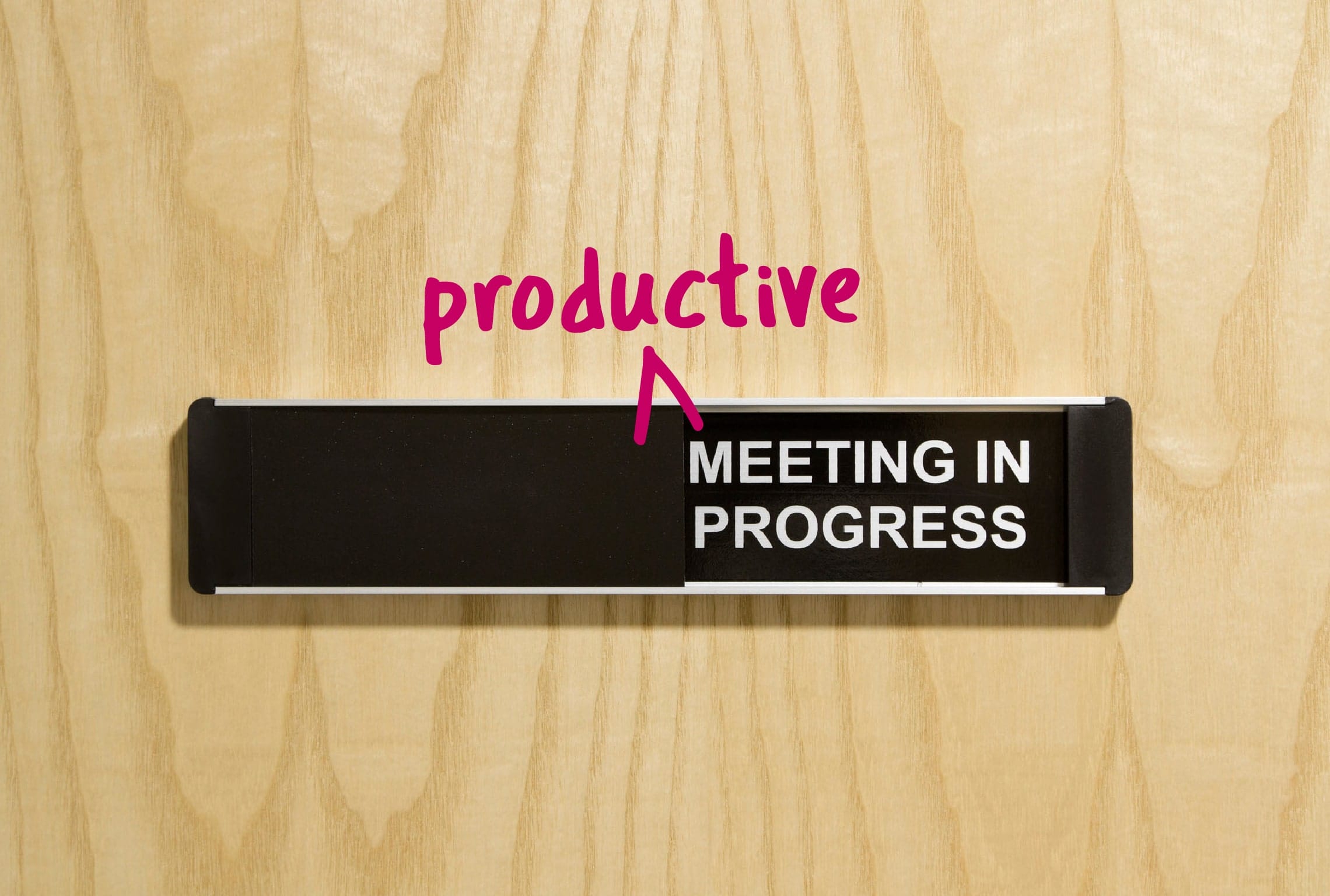
Most people find meetings painful – and often for good reason. They can lack a clear agenda, purpose, or direction, and easily get off track, wasting valuable time.
Salespeople typically detest meetings because they take time away from what they’d rather be doing: calling prospects, scheduling appointments, and closing deals. And since time is money, every minute a rep isn’t on the phone or meeting with clients is a minute wasted because they aren’t generating commissions.
Of course, no organization can completely do away with meetings. They’re important for keeping your team on the same page and on track toward goals. In fact, meetings can play a crucial role in boosting your sales team’s performance if you know how to run a sales meeting successfully.
With that in mind, keep reading for sales meeting best practices that will help you and your team get more value from your meetings and ensure they’re worth your time.
A sales meeting agenda is a structured plan that outlines the topics to be discussed, the time allocated for each topic, and the desired outcomes. It’s a roadmap for a focused, productive, and on-track meeting, ensuring key issues are addressed and objectives are achieved. A well-crafted sales agenda is essential for maximizing meeting effectiveness.
To ensure your sales meetings are productive and contribute to increased team efficiency, task clarity, and morale, follow these 9 core best practices:
The biggest hurdle when scheduling team sales meetings is finding a time that works for everyone. Monday morning meetings can be disruptive since sales reps are more concerned with returning their prospects’ calls or contacting any new leads that came in over the weekend.
Instead, schedule your weekly sales meetings for Tuesday or Wednesday afternoons. That way, people who have a habit of showing up late to work or skipping meetings due to morning phone catchup have no excuse.
Keep in mind that salespeople are always frantically busy near the end of the month or quarter, so be a little flexible around those critical times. If your company’s financial goals are dependent on your reps staying on their phones on the last day of the month, the weekly sales meeting can wait.
Pro tip: If you want to maximize attendance, offer incentives. Providing free lunch or coffee is a super-simple way to boost attendance.
Nutshell Scheduler lets you collect, scheduler, and manage bookings with your prospects, all without leaving Nutshell.

One of the biggest let-downs for employees is spending an hour in a room listening to their manager drone on and on, only to walk away not knowing why they were there in the first place. Everyone should leave your meetings knowing exactly why they needed to attend, and what their next steps are.
When your sales reps repeatedly leave your meetings wondering why they attended, they’ll be more likely to skip future meetings, indulge in distracting activities (like being on their laptops or phones), or steer the conversation off-topic.
Some legitimate reasons for a sales meeting are:
If you feel it’s essential to meet with your sales team regularly, ask them to share some sales team meeting ideas to ensure you always provide value and keep your reps engaged.
Related: Check out marketing extraordinaire Seth Godin’s “Whose Meeting Is This?” checklist and see if your next meeting hits all seven criteria.
One of the most effective sales meeting tips for keeping your meetings on track is to create an agenda beforehand.
Before gathering your team, take the time to outline the topics that will be discussed, how long each part of the meeting will take, and the outcomes you’re aiming for. A well-defined agenda will help keep the meeting on track.
Drafting a reusable, effective sales meeting agenda template can make all the difference, helping to streamline your meeting prep to-dos. With a structured template in place, it’ll be easier to maintain a sales meeting format that works best for your team.
Before the meeting, be sure to share the agenda with everyone who is attending so they can prepare and contribute meaningfully.
A sales meeting is not a one-way street. It’s a collaborative effort where everyone’s input matters.
Encourage active participation from all attendees. Create an open, inclusive environment in which team members feel comfortable sharing their input, ideas, and concerns.
When everyone has a voice, you tap into diverse perspectives, leading to innovative solutions and a stronger sense of ownership among team members.
Get 70+ expert strategies for sales management success in our Sales Manager’s Survival Guide.

The sales process is long and challenging, so taking a moment to recognize hard-fought battles, new deals, and other wins can really motivate and set the right tone.
Treat every win like it counts, no matter how big or small. Call special attention to those crushing their numbers since it not only boosts morale but shows others that those goals are attainable. This process of recognizing achievements is easy to skip, but don’t do it. Taking even just a few minutes to celebrate with your team at the beginning of your meeting can make the rest of your sales meeting agenda easier to swallow and, as a result, more effective.
Before the meeting, you should designate a certain timeframe for specific subjects, and consider pushing them to another meeting if they take too long to cover.
On top of that, be considerate of other people’s time by not letting employees ramble or get off-topic for too long. If their individual issues and conversations take up too much of the team’s time, then consider conducting mini one-on-one meetings with individual salespeople throughout the week. Those mini-meetings are the perfect opportunity to go over their sales dashboard and discuss individual concerns and questions or conduct specific training, freeing up meeting time for more pressing topics.
Maximizing attendance and productivity is all about sticking to your schedule. The last thing you want to do is let meetings creep past the allotted time because it tells your team that you don’t respect their time. If you let meetings run long, even by a few minutes, you could be inadvertently interrupting scheduled calls or meetings your salespeople had planned, costing them sales or breaking precious promises to customers.
True meeting productivity means having the right people with the right tools in the right place so decisions can be made. Invite all decision-makers for the tasks you want to tackle so that you can make real progress.
It’s also a good practice to start integrating your meetings with other departments if their input is necessary to create a plan or make decisions on certain subjects. Consider inviting representatives from your marketing and product teams to your weekly sales meeting so they can be aware of your team’s strategies and concerns and offer assistance as needed.
In the whirlwind of discussions, it’s easy to forget crucial details, action items, and decisions made during the meeting. Of course, if no one remembers what happened in a meeting, you won’t get much out of it. That’s why meeting minutes are one of the most important sales meeting best practices.
Designate someone to take notes during the meeting, or better yet, record the session if possible. Document key points, action items, and responsibilities assigned to individuals.
Make sure you end meetings with action items so that everyone knows what to bring for the next meeting. Clearly outline what the expectations are as they relate to customer or prospect cultivation.
It can also be helpful to send out a reminder before the next meeting so no one forgets their tasks.
A well-structured sales meeting agenda template is the foundation of a productive sales meeting. It provides a framework for discussions, ensures key topics are covered, and keeps the meeting on track. Here’s how to create one:
Following these steps creates a sales meeting agenda template for more productive and effective sales meetings.
Holding a productive sales team meeting isn’t rocket science, but it takes finesse, consistent tweaking, and planning. With enough foresight, you can transform your sales meetings into productive sessions your team actually looks forward to.
Not a Nutshell customer yet? Give our leading CRM solution a try. Our CRM includes a built-in scheduling tool, Nutshell Scheduler, and integrates with various booking tools, so it’s a great way to streamline your marketing and sales processes. If you want to see Nutshell in action, check out our 14-day free trial!
Take our guided tour to explore Nutshell’s incredible features!

Join 30,000+ other sales and marketing professionals. Subscribe to our Sell to Win newsletter!
 Email & Calendar Sync
Email & Calendar Sync
Use our calculator to add up your total investment of CRM and Add-ons
VIEW ALL PRICING
 Product Info
Product Info Education & Guides
Education & Guides Company
Company